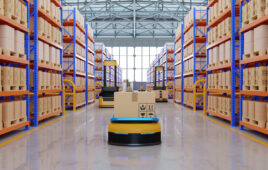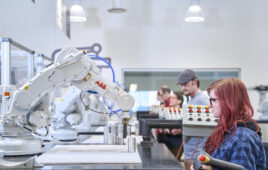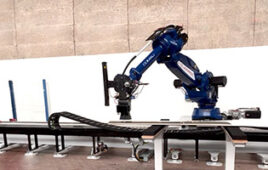Design World’s VP, Editorial Director Paul J. Heney chats with Bradford L. Goldense, one of the 18 judges for this year’s inaugural LEAP Awards. Goldense discusses the challenges of such an immense undertaking, as well as some of the technology that most impressed him.
[A lightly edited transcript follows …]
DW: Hello, and welcome to a special edition of Design World’s Executive Edition podcast series. I’m Paul Heney, V.P. Editorial Director of Design World. Today I have one of our esteemed judges for this year’s LEAP Awards as my guest. Bradford L. Goldense is the CEO of Goldense Group, a Massachusetts-based consulting, education and research firm that’s been providing advanced business and technology management services to companies that create and commercialize products since 1986. Brad, thanks for joining us here today.
BG: Well thanks. Glad to be with you.
DW: I just wanted to talk to you a little bit about the Leap Awards and what your feelings were on the judging end of things. Could you give me your broad overview of what judging was like for you this first year of this inaugural competition?
BG: It’s kind of an adventure. Exciting in this first year to be sure. When the submitting process closed in early September I think all of us judges were kind of on the edge of our seat wondering exactly how many things would come in. And a few days later this email, inconspicuous email arrived in the email box and I opened it and probably I’m betting my reaction was like most of the judges. I kind of went, “Holy smoke.” There were quite of bit of things there to look at but then I think all of the judges digested it in about the same way because you were the guy that we were sending our questions to.
But we all kind of sent our questions in the same period of time and you were great. You got right back to it while it was all fresh in our minds and clear directions. So everything settled down right away. I think, based on how we all resolved it together that pretty confident and when you and Lisa Eitel went on the livestream last Friday, November 02, and we got to see who all the finalists were it gave me a good idea of who else and what other things had been submitted that were not in the categories that I was looking at. And I kind of am looking forward to the award ceremony in December 11th in Costa Mesa. See who all wins at the DeviceTalks West.
DW: Can you talk a little bit about what types of things you saw this year that impressed you Brad?
BG: Well as you know, there were 11 categories. For me, I judged in three of them. Industrial automation, additive manufacturing and advanced material. So my own person highlights were in those areas.
DW: Sure.
BG: Not to add to the 3-D hype, which is very real at this time and soon to become mainstream but the submissions from 3-D Systems, their high-volume additive manufacturing machine and the Hewlett Packard Jet Fusion printer, just spectacular examples of how that technology has evolved since the origination of 3-D printing in the late 1980s. Two very impressive products. Schneider’s Augmented Reality Operational Advisor also stood out. I did a little bit of checking. I’m not 100% sure but it seems to me to be either the first or among the first handful of user programmable augmented reality tools for operational safety and maintenance and it gave me a really good feel that it really did create operational safety for the people that were using it.
Also in industrial automation in the IIOT it was interesting to see the numerous offerings that perform some type of integration between legacy unconnected devices that exist in every factory and enable them to be connected up to the IIOT. Products were kind of a wide range to do that, everything from retrofitting robots with sensors to control centers that you plug everything into, to software that would actually allow untrained folks to actually do programming that was eye-opening.
Lastly, so several good examples of industrial design are coupled with the functionality. Industrial design is becoming increasingly important and Cognex in that case stood out for me. Cognex seems to understand the importance of industrial design. It’s important.
DW: So Brad, I’ve heard through the grapevine that some of the Leap judges have started interacting let say, outside of the strict judging platform. So what’s happening there?
BG: Well I might have been a culprit on that because it just coincidentally one or two or the judges were folks that I had run into across the years.
There were 18 of us judges. Bit of a surprise, LinkedIn was helpful. I could find them and say, “Hi.” Most of them have responded and offered their own thoughts on their own experience. I think we all had a common interest to know if we scored consistently. Several folks mentioned that. And of course who won, I think there was a bit of insecurity on that and that would be normal. That means everybody’s conscientious. Several folks mentioned the number of PR firms submitted on behalf of their customers and clients. Several of us actually wondered if their clients knew they had done that or wanted to pleasantly surprise their customers in the end, but that was somewhat unexpected.
Several folks commented as well, that it took quite a bit of time to do it. I know that was the case for myself as well so both the folks that submitted and WTWH because it means that we all took it quite seriously.
DW: What suggestions would you give for future submitters? What can they include to make your job as a judge easier, like thinking ahead to the 2019 LEAP Awards?
BG: Oh, good question Paul. There was really quite a range of materials. Some folks had a 10 or 12 page submission form. It was like a small thesis. Photographs, some of them had 10, 12 different images, graphics, illustrations. Others, there was a minimal one to two page form with information and one graphic. So it think all the judges probably felt that same way. I offer that a consistently done five pages of description would be help … a little bit of uniformity along the length of the description would improve the ability of us to judge evenly.
And images that give us a 360° view of the product and a couple of images that allow us to really zoom in and see the details of how a user interfaces with the product. I’d say if it’s done right, it’s a five page description and four to five photographs or images or graphics each. And a little bit of uniformity around that gives everybody a better of judging correctly and submitters the chance of, better chance of making sure that we’re fairly understanding their product.
The other thing I’d say is that if you have new-to-the- world features or capabilities or you’re utilizing some new technology in a first time real-world app don’t try and be too polite about it. Just spell it right out in the description. Be declarative and make sure that you clearly address and state the key features for the product that you submit. The key features to me are what would be the things and reasons that your customers buy that specific product for versus buying your competitor’s product?
DW: Oh, that makes sense. So Brad lastly, will you be joining us in California on December 11th for the award ceremony?
BG: Oh, I wouldn’t miss it Paul. Definitely. For sure, and I think from the judges that I’ve talked with I know at least another seven or eight are going. I only know of one that was unable to go because of a schedule conflict. I’d also like to say that I’m somewhat aware of other judging competitions and WTWH has been very classy in the way that it is respecting the judge’s time and it was quite a bit of time, by flying us out there and making sure that we get to see the award ceremony and understand and talk with each other to make us all a little bit better next year. I’m very much looking forward to going.
DW: All right. Well thanks again once again Brad for your judging and for joining us here today and we’ll see you next month.
BG: Well thanks. It was a pleasure.
DW: And to our listeners, you can see the Leap finalists at designworldonline.com. Thanks for listening. Until next time, this is Paul Heney signing off.
Filed Under: IoT • IIoT • Internet of things • Industry 4.0, Robotics • robotic grippers • end effectors




